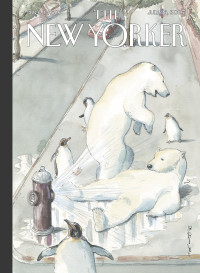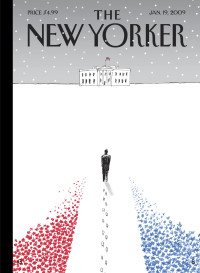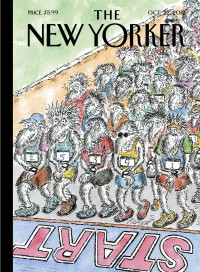Also available as an issue of my newsletter, Leaflet
Top Gun: Maverick opens with Tom Cruise sitting in a chair, out of character. He thanks the audience for leaving their homes to experience the movie on a big screen. When Peter and I went to see Maverick in a movie theater, the other night, I was surprised by how old Cruise looked. He’s much better preserved than most civilians, of course, but in an age of motion capture and CGI, it’s a choice for a star like Cruise to allow his age to be visible. It occurred to me that the movie’s preface might have an ulterior purpose: to give the audience a moment to adjust to what time has done to the man who has long played the hero of their fantasies.
Cruise’s age is decidedly diegetic in the movie that follows. His character, Pete “Maverick” Mitchell, is still flying planes for the Navy, more than three decades after the fictional events of the first Top Gun movie, and Maverick’s persistence in his vocation is understood, within the movie’s storyline, to be both failure and success. Failure, because Maverick is still just a captain all these years later, having refused to, or having proved unable to, accommodate himself to the military as an institution. Success, because, after three-plus decades of just flying planes, he’s very good at it. The ambiguity shrouds Maverick the way his black leather jacket does. It’s the same kind of jacket he would have worn more than three decades earlier—maybe it’s even the very same jacket—and we remember how in those days it seemed to participate in his virility. On a man in his fifties, however, an article of clothing that was archetypally sexy a generation ago has a certain pathos. (I say this as a man in his fifties.) Cruise looks great, but the jacket and the teardrop-shaped aviator sunglasses that go with it remind us so sharply of what Cruise looked like thirty-six years ago that they accentuate the contrast with his earlier physical self. We’re meant, I think, to feel a little sorry for him for still trying, and to feel bad that we feel that way. Which is, unexpectedly, a gentle feeling.
Top Gun: Maverick turns out to be a longitudinal movie, one that plays on and with the passage of time as it can be seen telling on the bodies of its actors, like Richard Linklater’s Before Sunrise, Before Sunset, Before Midnight, and Boyhood; François Truffaut’s Antoine Doinel movies; and David Lynch’s Twin Peaks: The Return. In this class of movies, there can be moments of almost unbearable poignancy, exceeding the usual aesthetic frame around a movie. The passage of time can seem to be collapsing as one watches. A great role is a vital moment in the life of an actor, and when an actor revisits such a role, the viewer is aware of watching not only a fictional character’s resurrection but also a real person confronting a work of art that he may have thought at the time that he was the master and creator of, but which, in the years since, he has probably come to realize he was shaped by in ways he could never initially have intended, no matter how consciously he then thought he was working.
The first essay I ever wrote for my blog was about the original Top Gun. Peter and I watched it on a DVD mailed to us by Netflix, in April 2003, neither of us having seen it during its 1986 release, when we were teenagers. Peter now has no memory of having watched it at any time, but I looked my old essay up on my phone the morning after we saw Maverick. I was so angry in 2003! I wrote so knowingly! I seemed so certain of the points I was scoring against my enemy, whoever that was! Maybe a blog can be longitudinal, too? It was all so long ago.
In the spring of 2003, America was invading Iraq for the second time, and Top Gun was already an old movie, time-traveling from an America that hadn’t gone to war for a generation and was on the verge of discovering that it had a hankering to kill again. By 2003 America had consummated that desire, and I was angry, I think, because the Top Gunof 1986 seemed to me to have done what Marxians call ideological work toward that end. My theory seems to have been that the movie had whetted an appetite for violence by manipulating its male viewers’ anxieties about inadequacy and about having feelings for other men that were too strong. It was hardly a reach for me to come up with such a theory. In those days, to justify the U.S. military’s don’t-ask-don’t-tell policy, psychologists like Charles Moskos theorized something similar. It was understood that very few soldiers are willing to die for something as abstract as a nation and in practice risk their necks only for the other people in their unit whom they have become close to. Moskos thought open homosexuality would interfere with what he called unit cohesion. The military needed for soldiers to feel close but not in that way. If they started making love to each other, they would stop loving one another.
The year 2022 calls for different ideological work. America has lost its appetite for war. In fact it no longer has the stomach to digest the ones it’s still fighting, and consequently there is little discussion by journalists, and virtually none by politicians, of what we’re doing in Somalia, where we recently increased our military presence, or of our ongoing complicity with war crimes and humanitarian catastrophes in Yemen. In 2003, I thought Top Gun was a movie about short-circuiting mourning in order to induce a mindset more amenable to killing. Maverick, however, is just a movie about mourning. Period. Which isn’t to say it’s honest; more on its disingenuousness in a moment. But despite that disingenuousness, it is, surprisingly, a movie about decline and loss, visible from the movie’s very first frames in Cruise’s weathered face. Val Kilmer also reprises a role from the first Top Gun movie, and Kilmer, who in real life is recovering from throat cancer, is even more cruelly changed by time. His character tells Cruise’s, at one point, “It’s time to let go.” Cruise resists, of course, and the movie’s highs, which are considerable—I won’t pretend I didn’t enjoy the ride, and I even recommend it—stem from the fantasy that a man in late middle age can have one last hurrah. I think the viewer is meant to experience the hurrah on the screen as fantasy; I think the movie wants the viewer feel that Kilmer is right, that the end is coming, that, in fact, it’s pretty much here.
The sequel gestures toward rehearsing the neoliberal sermons about masculinity preached in the original. In Top Gun, the danger was that Cruise would feel too guilty about not having saved his fellow aviator Nick “Goose” Bradshaw to make a good soldier. In Maverick, the corresponding character flaw, which the screenwriters have given Goose’s son, Bradley “Rooster” Bradshaw, is a tendency to “overthink,” to delay firing until sure everything will work out. Which isn’t on the same level at all. In an early scene in a bar, a new generation of young aviators mock Cruise as “Pops” in a jolly hazing, tossing him out to the street when he can’t pay his bill. In Top Gun, it was Cruise’s short stature that signaled that he was a beta struggling in a world of alphas; in Maverick, it’s his age. In both movies, his smile encodes his survival strategy—submission without deference. Cruise is able to make being thrown out of a bar look like crowd-surfing. There’s no longer quite the same arousing and threatening scent of testosterone in the air, though, no longer quite as strong a sense that Cruise is the lone dolphin in a school of sharks. This is a war movie for the Ted Lasso era, when, instead of idealizing the free market of male egos, audiences want to see people on screen being kinder to and more understanding of one another than almost anyone in real life has the emotional wherewithal to be. Among the young aviators in Maverick, only one has the full-fledged blond-beast frat-boy assholishness that prevailed when Cruise himself was a student. In real life, that archaic style has been exploded, and in a military context, even rendered nauseating by the war crimes of people like the Navy SEAL Edward Gallagher. I’m not saying it doesn’t exist any more; of course it does, and it’s still dangerous, but in the way of a cornered rat. Viewers know that if such a personality still tends to show up in elite military fighting units, it’s to some extent because it thinks it can take refuge there. And is safe not even there, really. One of the young aviators who makes the cut onto the final mission team is a woman, and another, perhaps even more tellingly, is a man whose call sign, “Bob,” is no more than his real name. The joke is that he isn’t even trying to be something other than ordinary. Maybe he’s gay? It would make a certain kind of metaphoric sense that in a post-closet world, the gay would be the one without an alter ego.
As for that disingenuousness: Ideology’s weapon, in the sequel, is nostalgia. The viewer is meant to sigh a little over the way technology is forcing pilots like Cruise and his young protégés into extinction. A colonel nicknamed the “Drone Reaper” is said to be shuttering the Navy’s dogfighter programs in order to pour more money into unmanned aerial vehicles, and the implication is that Cruise is a John Henry, who can’t help but keep trying to prove humanity’s superiority to machines, which is to say, to capital. “It’s not the plane, it’s the pilot,” is Cruise’s refrain in the movie, and his character totals half a dozen fighter jets, with as much abandon as if they were so many Ferris Bueller Ferraris. In reality, even though drones are replacing fighter jets, militaries today are more capital-intensive than ever, which, some economists theorize, is why America’s heavy military expenditure over the past quarter century failed to redistribute wealth the way that military expenditure during World War II did. Now more than ever, a nation may be understood as a population that can be taxed so reliably that you can take out a loan against the taxes; if you want to know who’s going to win a war, figure out which side has access to better (deeper, more continuous) financing.
Of all the reasons to feel bad about drones, the withering away of pilots may be one of the weakest. From the point of view of people being bombed on the ground, jets were never any more sporting than drones are. The nostalgia trip offered by Maverick is one last fight the old-fashioned way—a return to an ignorance that drone warfare has made more difficult. The nationality of the enemy that Cruise and his team are fighting is never named, and when the enemy pilots appear on screen, they’re hidden inside bug-like flight suits with opaque visors. In fact, thanks to drones, soldiers today often watch the people they have been asked to kill for so long that they begin to feel a kind of intimacy with them—and nonetheless still sometimes end up killing innocent civilians. And sometimes also end up becoming aware that they have done so. In a recent New York Times article about the moral injury that soldiers are now subject to, there’s a haunting story: An intelligence analyst working at an Air Force base is asked to take out a target in Afghanistan said to be a high-level Taliban financier. The analyst and his team track the man for a week, watching him tend his animals and eat with his family, and then a pilot on the team kills the man, remotely. A week later the man’s name appears on the target list again. They killed the wrong guy. This happened two more times, the analyst told the Times, before the analyst threatened to kill himself, was talked out of it, and was “medically retired.” In Top Gun: Maverick the fantasy is that it’s still possible to fly over these moral compromises at Mach 10 speed.













